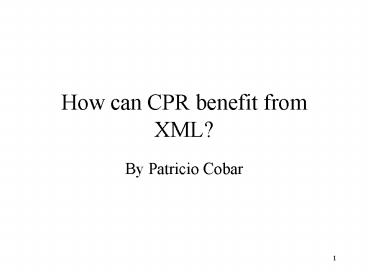How can CPR benefit from XML? - PowerPoint PPT Presentation
Title:
How can CPR benefit from XML?
Description:
How can CPR benefit from XML? By Patricio Cobar – PowerPoint PPT presentation
Number of Views:86
Avg rating:3.0/5.0
Title: How can CPR benefit from XML?
1
How can CPR benefit from XML?
- By Patricio Cobar
2
Outline
- What is CPR?
- What is XML?
- Benefits of using XML in CPR systems
- XML a language we can all understand
- The document hierarchy
- Representing the medical record (XML vs.
databases) - XML and the CPR architecture
- To each his own
- Supporting industry standards
- Summary
- Conclusion
3
What is CPR?
- Computer-based Patient Record.
- Electronically maintained information about an
individual's lifetime of health status and health
care. - CPR systems serve as research facilities in which
large quantities of health information is made
available while maintaining the confidentiality
of patients and providers. - Web-based CPR systems use Internet technologies
to accomplish their goals.
4
What is XML?
- eXtensible Markup Language.
- Just like HTM, it is used to define how pages
appear in web browsers. - Unlike HTML, It provides a context for
information, defines what the piece of
information actually means. - Allows the use of customized tags.
- Supports infinite levels of hierarchal of
information.
5
What is XML? (CONTINUED)
- Context-less
- ltHTMLgt
- ltBODYgt
- ltBgt
- important piece of information )(
- lt/Bgt
- lt/BODYgt
- lt/HTMLgt
- Context-sensitive
- ltXMLgt
- ltimportant_piece_of_information VALUE )(
gt - lt/important_piece_of_informationgt
- lt/XMLgt
6
XML a language we can all understand
- With XML we can explicitly describe the names of
the pieces of data we are collecting. - Easily understood by humans and computers
7
Easily understood XML file
8
The Document Hierarchy
- XML supports infinite levels of hierarchical
information within a document (tree-like
representation). - The format of used in medical records is
source-oriented. Data are grouped according to
the source that generated the data (also
tree-like representation).
9
XML vs. Databases
- Databases do not provide the level of detail that
XML is able to represent. - The relational database model represents data
using entities and relationships. XML employs a
document-centric approach. - Representing a medical record using a relational
database is more complicated. - Because XML is so widely use, database vendors
have built XML facilities into their latest
database products.
10
Sample Medical Record
11
XML and The CPR Architecture
12
To Each His Own
- CPR systems must be able to produce a different
screen for every group accessing the medical
record. - eXtensive Style Sheets (XSL) is a feature of XML
that we can use to produce different outputs
based on the same data
13
Supporting industry standards
- Through the use of Document Type Definitions, XML
can help enforce standards. - . By using DTD along with industry standards, we
can improve the completeness of the medical
record by providing a clear description of the
content of the data in the medical record.
14
Summary
- XML gives you a standard and more legible way to
represent the medical record than traditional
databases. - XML can help healthcare professionals enforce
standards and, at the same time, improve the
completeness of the medical record. - Facilitate the exchange of medical records.
15
Conclusion
- There is already a place for XML in the CPR
architecture, the integration engine. - Sharing this document throughout the enterprise
or with external systems presents no problem, the
XML medical record contains a standard structure.
16
References
- Pothen, Daniel, and Bambang Parmanto. XML
Furhters CPR Goals. Journal of AHIMA. October
2000. - Available at http//www.ahima.journal.cutting.edg
e/0010.html - Sokolowsky, Rachel. XML Makes it mark. Journal
of AHIMA. November 1999. - Available at http//www.ahima.journal.cutting.edg
e/9911.html - Young, Michael. Step by Step XML. Redmon
WA.Microsoft Press, 2000. - Kibbe, David, Bard, Mark R. How Safe Are
Computerized Patient Records? American Academy
of Family Physicians. - Available at http//www.aafp.org/fpm/970500fm/lea
d.html































